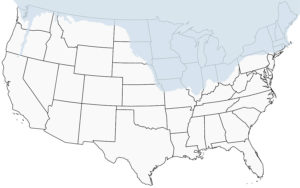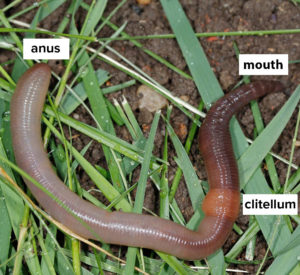As gardeners we're taught that the presence of earthworms is a sign of soil health, and it's true that in many cases earthworms enhance the soil in ways that benefit plants. For example,
- Earthworms create tunnels, loosening compacted soil and allowing water and nutrients to infiltrate. This helps lessen water run-off while also increasing the water-holding capacity of the soil. In addition, the loosened soil encourages healthy, extensive plant root systems.
- They're detritivores; that is, they're on the front lines of breaking down organic matter, such as fallen leaves. As worms consume organic matter, it passes through their digestive tracts where the nutrients it contains are converted into forms plants can use. In the process, the waste is inoculated with microorganisms present in the worm's digestive tract. When the worm excretes the waste (worm poop, also called castings), the microbes are also released, enlivening the soil ecosystem. Worm castings are a highly valued garden fertilizer.
- Worm castings act like a glue to bind soil particles, creating soil aggregates, or clumps — a hallmark of healthy soil — that create abundant pore spaces so that air and water can reach plant roots.
However, did you know that native earthworms were essentially eliminated from the northern and central U.S. more than 10,000 years ago? During the Ice Age, the frigid fingers of those colossal glaciers reached into the Northeast and Upper Midwest as far south as Missouri and Pennsylvania. The movement of the glaciers severely eroded the land, destroying most native earthworms. When the glaciers receded, the forest ecosystem slowly recovered — but it did so without the presence of earthworms.Fast-forward to the 1600s, when settlers from Europe began introducing earthworms into to these northern areas. Some worms were brought intentionally to improve garden soil; others likely hitched rides in mulch and plant pots. Over time, the earthworms traveled deep into forested areas as fishers discarded their worm bait streamside, muddy off-road vehicles carried worms on their wheels, and networks of logging roads created access for trucks and machinery that inadvertently transported earthworms ever deeper into the woods. More on these interloping forest worms later.
Fun Facts about Earthworms
- The informal term worm is used to describe any of the numerous elongate, soft-bodied animals, including earthworms as well as parasites such as tapeworms, pinworms, etc.
- The term earthworm describes a terrestrial invertebrate belonging to the phylum Annelida, a biological classification that includes ringed and segmented worms.
- Nightcrawler refers to a specific earthworm species, Lumbricus terrestris.
- Charles Darwin was fascinated by earthworms. For 40 years he conducted experiments, culminating in the publication of an 1881 book titled The Formation of Vegetable Mould through the Action of Worms, with Observations of their Habits.
- There are more than 7000 species of earthworms worldwide, ranging in length from an inch to 6', and occur in most temperate soils and many tropical soils.
- Worm castings are rich in iron, sulfur, calcium, nitrogen, phosphorus and potassium. As worms excrete their castings, the little pellets receive a thin coating that slows the release of the nutrients within. In effect, worm castings are naturally pelletized, organic, slow-release fertilizer!
Types of Earthworms
Earthworms can be divided into three categories.
Surface dwellers. Typically relatively small, they're adapted to widely varying temperature and moisture levels where the soil meets the air.
Dwellers of the upper soil levels. These species feed on soil and organic matter. Rather than forming permanent burrows, they simply move through the soil, backfilling their tunnels with their castings.
Burrowing species. Members of this group, which includes the nightcrawler, create permanent or semi-permanent systems of burrows that may extend several feet down into the soil. They will often pull surface organic matter down into their burrows to feed, mixing the soil layers and speeding the decomposition of organic matter and subsequent release of nutrients.
Earthworm Anatomy
As mentioned above, earthworms are members of the phylum Annelida, Latin for "little rings." An earthworm's body has 100 or more small rings or segments that are fused together to form the body. Each segment has bristles called setae (SEE-tie or SEE-tee) and a ring of muscle that can contract or relax independently of other segments; these features allow the worm to move.The worm's digestive tract runs the length of its body, and it features a gizzard that uses small stones and grit ingested by the worm to grind the food into pulp. It also has a brain, as well as a heart, blood, and circulatory system. It does not, however, have lungs: Earthworms breathe through their skin, where oxygen and carbon dioxide pass back and forth through diffusion. For this to occur, the skin must be moist.
Earthworms don't have eyes, but they do have a light-sensitive patch that allows them to avoid exposing their delicate skin to the drying effects of sunlight. Earthworms also do not have ears; however, they are extremely sensitive to vibrations and movement.
Earthworm Life Cycle
Like many creatures, an earthworm starts out life as a fertilized egg, which in two to three weeks hatches into a tiny, threadlike worm. As the worm grows, new segments develop behind the head. When the worm is a few weeks to a few months old, an enlarged, pale band develops on the anterior (head) end. This is the clitellum, which contains the worm's sex organs.
Earthworms are hermaphrodites, meaning each worm has two sex organs — one that produces sperm, one that produces eggs. However, most earthworms aren't self-fertile — in other words, producing offspring requires mating with another earthworm. During mating, the worms exchange eggs and sperm. A cocoon (egg case) containing eggs and sperm forms on each worm's clitellum, and as the worms shed their cocoons, fertilization occurs. The fertilized eggs in their protective cocoons can remain dormant for several years until conditions are right for the eggs to hatch.
Native vs. Non-Native Earthworms
There are about 100 species of earthworms native to the unglaciated areas of the U.S., mostly the Southeast and Pacific Northwest. These native worms are migrating slowly, if at all, to the previously glaciated areas. Most of the earthworms found in the Northern Midwest and Northeast are non-native species that were introduced, either intentionally or inadvertently, as mentioned above. These non-native earthworms are disrupting forest ecosystems, sometimes with catastrophic results for native species of plants and animals.
When non-native species are introduced into an established ecosystem, the delicate balance of interconnected species is changed. Sometimes the effects are minor; however, in the case of earthworms, the effects are obvious and far-ranging. This is especially true in mixed hardwood forests. Here's why:
As the deciduous trees, shrubs, and other plants shed their foliage, it drops to the forest floor where it creates a thick layer of organic matter called duff. Without the presence of earthworms, this duff decomposes slowly, primarily through the action of bacteria and some fungi. Thus, the delicate forest soils are continuously protected by layers of organic matter in various stages of decomposition. This supports a wide range of understory plants, including ferns, spring-blooming "ephemeral" flowers, and tree seedlings, as well as the other plants and animals that depend upon them.
In forests colonized by a large population of earthworms, the decomposition of organic matter speeds up, sometimes to the extent that bare soil is visible. This change renders the area inhospitable to many understory plants, so that the area beneath and between the trees becomes barren or is colonized by just a few species of particularly adaptable (and sometimes invasive) plants. This results in the reduction (and even elimination) of some native species and a severe reduction in the number of tree seedlings – trees needed to replenish the forest over time. Once an area is colonized by earthworms, it's impossible to eradicate them.

Left: Sugar maple tree prior to earthworm infestation showing layer of fallen leaves leaf (duff) protecting the soil on the forest floor. Right: Tree with roots exposed due to non-native earthworm activity. Photo courtesy Robert Lee, Bugwood.org
Jumping worms. Not all foreign earthworms are destructive; only a dozen or so of them are known to cause significant damage. One of these, the jumping worm, has made recent headlines for its "crazy" behavior — giving it another common name, the crazy worm. When handled or disturbed, the worms thrash about, spring into the air, and will shed their tails if necessary to escape. (The internet abounds with videos of their bizarre antics.) Likely introduced in the 1800s, these worms (species in the genus Amynthas) have slowly but steadily colonized forests in the Midwest. Jumping worms grow quickly, eat voraciously, and reproduce more quickly than many other types of earthworms — and don't need a mate to do so. Once established in an area, they quickly transform the soil into dry granules, a state that is inhospitable to the roots of most plants.
Composting Worms
The type of worm most commonly used in worm composters is the red wiggler worm, Eisenia fetida. This species, which is native to Europe, is favored for use in both domestic worm bins and commercial composting facilities. Red wigglers are the worm of choice for several reasons. These surface-dwellers are voracious eaters — each worm can easily consume over 1/4 of their body weight every day. They're tolerant of a comparatively wide range of temperatures (from about 40 to 90° F), though they prefer temperatures of 55 and 75° F.
Red wigglers are purchased and shipped all across the country for use in composting. Although they are not considered an invasive species in North America and don't appear to have a negative impact in the wild, that status could change. The worms likely wouldn't overwinter in colder regions, but could become naturalized (form long-lived populations) in moderate climates. Due to this potential, it's best not to release red wigglers into natural areas. If a worm bin becomes overpopulated, try to use the extra worms to expand your bin or give them to someone just starting out. If you need to destroy the worms or are concerned about using worm compost in an outdoor garden space, you can kill them (and their eggs) by freezing the compost for at least a week.
Resources
For more information about invasive earthworms in your region, contact your state's department of natural resources or your county's cooperative extension service.
Great Lakes Worm Watch
Jumping Worms (includes video)





